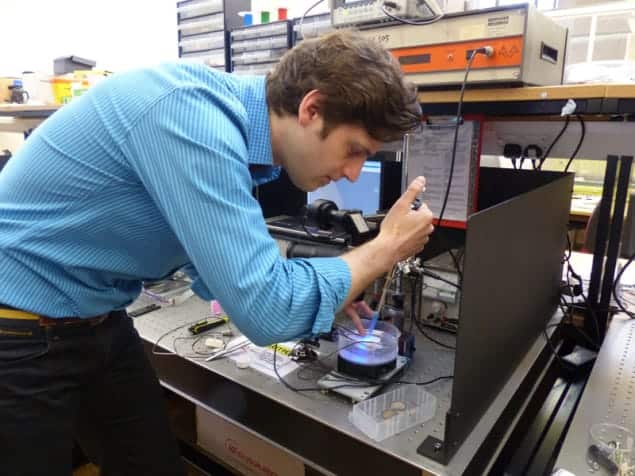
A metamaterial with acoustic properties that can be reconfigured in less than one tenth of a second has been made by researchers at the University of Bristol in the UK. Created by Mihai Caleap and Bruce Drinkwater, the device comprises tiny polystyrene spheres suspended in water. The spheres arrange themselves in a cubic lattice that is defined by criss-crossing acoustic standing waves. The lattice blocks sound at certain frequencies that depend on the spacing between the spheres and, with further development, it could be used to create lenses that focus sound or even acoustic cloaks.
Caleap and Drinkwater’s work builds on the experience physicists have gained over the last few decades in making “optical lattices” by shining criss-crossing laser beams through a dilute gas of ultracold atoms. Depending on the wavelength of the light and the type of atom, the atoms are drawn to regions of either high or low light intensity formed by standing waves of light. The result is a crystalline lattice with one atom per maxima or minima that physicists can then use to study fundamental quantum phenomena.
A sound idea
The Bristol duo has now essentially done the same thing with standing waves of sound at ultrasonic frequencies. Using piezoelectric loudspeakers, they set up standing waves in the x, y and z directions in a finger-tip-sized sample of water. This creates a 3D square lattice of regions of high and low density that is analogous to the bright and dark regions of an optical lattice.
When tiny polystyrene balls about 90 µm in diameter are placed in the water, they settle in the nodes of the standing waves, creating a 3D square lattice. The lattice spacing is related to the wavelength of the standing waves. For a 3.75 MHz ultrasound signal, for example, the spacing is about 279 µm.
Unique and useful
To demonstrate that the system works as an acoustic metamaterial, the researchers measured its ability to transmit ultrasound waves between 2 and 12 MHz. For randomly arranged spheres, the transmission fell as expected at about 6 MHz and did not recover at higher frequencies. In the case of a square lattice of the same density, however, the transmission spectrum was very different. The researchers studied square lattices with three different spacings and found peaks and troughs in the spectra between 6 and 12 MHz.
This behaviour is indicative of a “phononic crystal”, in which sound at some frequencies passes freely through the material, whereas signals at other frequencies are reflected back. It is the same effect that occurs to electrons in crystalline materials – giving rise to electronic band structure – and also to light in photonic crystals.
Rapid reconfiguration
Although phononic crystals have been made before, Caleap and Drinkwater say that theirs is unique because it can be reconfigured in about 0.05 seconds by changing the frequency of applied sound waves. It could therefore be used to make a reconfigurable ultrasound filter for medical applications.
Although their photonic crystals have wavelengths in the 100 µm range, the technique could be extended a wider range of lattice spacings of even up to metres. Drinkwater says that the method will work on “nearly all” solid-fluid combinations and will enable “almost any geometry to be assembled”, while being in addition cheap and easy to integrate with other systems. In fact, the metamaterial is also expected to work on electromagnetic radiation at terahertz frequencies. This suggests that the technology could be used in filters and beam deflectors for security scanners that use this notoriously difficult-to-handle part of the electromagnetic spectrum.
Ultrasonic superlenses
The team is currently working on acoustic lenses that can be reconfigured in real time and that are capable of “super-resolution” imaging, which means it could be part of a system that uses ultrasound to resolve features much smaller than the wavelength of the sound. To create such superlenses, Caleap and Drinkwater are using larger arrays of piezoelectric transducers that create standing waves over a wide range of frequencies. Such arrangements can create acoustic lattices with parameters that vary in space and therefore have the desired lensing properties.
The researchers have also found evidence that their suspensions of tiny balls share an important property with some metamaterials used to create electromagnetic invisibility cloaks: a negative index of refraction. This occurs because of a resonant interaction between the sound waves and individual spheres in the suspension.
The research is described in the Proceedings of the National Academy of Sciences.




